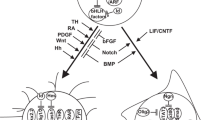Conclusion
It would seem that distinct genetic changes in different genes, the protein products of which interact in particular growth control mechanism may lead to the same cellular abnormality. This is exemplified in the case of the gliomas by the ways in which p53 and the Rb1 phosphorylation mechanisms may be rendered impotent. It seems likely that many further genetic abnormalities affecting genes coding for proteins, either involved in the cellular mechanisms identified or in new growth control mechanisms, will be found in the future. In total our results indicate both differences and similarities between the molecular genetic alterations in tumors with oligodendroglial and astrocytic differentiation. The loss of genetic information from 19q and 1p as well as the rareness ofTP53 mutations in oligodendroglial tumors suggests that the early events in their oncogenesis are distinct from those associated with astrocytic tumors. However, similarities are indicated by the allelic losses on 9p and 10 in the anaplastic tumors, suggesting the utilization of common pathways of progression.
Similar content being viewed by others
References
Collins VP, James CD: Gene and chromosomal alterations associated with the development of human gliomas. FASEB J 7(10): 926–930, 1993
Ekstrand AJ, Longo N, Olson JJ, Lui L, Collins VP, James CD: Functional characterization of an EGF receptor with a truncated extracellular domain expressed in glioblastomas with EGFR gene amplification. Oncogene 9: 2313–1320, 1994
He J, Allen JR, Collins VP, Day III RS, James CD: CDK4 amplification is an alternative mechanism to p16 gene homozygous deletions in glioma cell lines. Cancer Res 54: 5804–5807, 1994
Ichimura K, Schmidt EE, Yamaguchi N, James CD, Collins VP: A common region of homozygous deletion in malignant human gliomas lies between the IFN-α/ω gene cluster and the D9S171 locus. Cancer Res 54: 3127–3130, 1994
Kleihus P, Burger PC, Scheithauer BW: Histological typing of tumors of the central nervous system. Berlin, London, New York, Springer-Verlag, 1993
Reifenberger G, Liu L, Ichimura K, Schmidt EE, Collins VP: Amplification and over expression of the MDM2 gene in a subset of human malignant gliomas without p53 mutations. Cancer Res 53: 2736–2739, 1993
Reifenberger G, Reifenberger J, Ichimura K, Meltzer PS, Collins VP: Amplification of multiple genes from chromosomal region 12q13-14 in human malignant gliomas: preliminary mapping of the amplicons shows preferential involvement of CDK4, SAS, and MDM21. Cancer Res 54: 4299–4303, 1994
Reifenberger J, Reifenberger G, Liu L, James CD, Wechsler W, Collins VP: Molecular genetic analysis of oligodendroglial tumors shows preferential allelic deletions on 19q and 1p. Am J Path 145: 1175–1190, 1994
Schmidt EE, Ichimura K, Reifenberger G, Collins VP: CDKN2(p16/MTS1) gene deletion or CDK4 amplification occurs in the majority of glioblastomas. Cancer Res 54: 6321–6324, 1994
Sugawa N, Ekstrand AJ, James CD, Collins VP: Identical splicing of aberrant epidermal growth factor receptor transcripts from amplified rearranged genes in human glioblastomas. Proc Natl Acad Sci USA 87(21): 8602–8606, 1990
Author information
Authors and Affiliations
Rights and permissions
About this article
Cite this article
Collins, V.P. Genetic alterations in gliomas. J Neuro-Oncol 24, 37–38 (1995). https://doi.org/10.1007/BF01052656
Issue Date:
DOI: https://doi.org/10.1007/BF01052656




